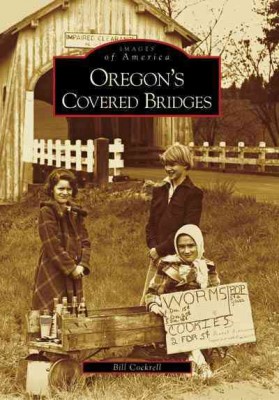| Oregon's Covered Bridges Contributor(s): Cockrell, Bill (Author) |
|
 |
ISBN: 0738558184 ISBN-13: 9780738558189 Publisher: Arcadia Publishing (SC) OUR PRICE: $22.49 Product Type: Paperback - Other Formats Published: May 2008 Annotation: Rugged individuals armed with hand tools, sweat, and ambition began building covered bridges in Oregon during the mid-1850s. These bridge builders often camped out at remote sites, living off the land or contracting with local farmers for food. Early owners of covered bridges financed construction by charging tollsa3A[ for a sheep, 5A[ for a horse and rider, and 10A[ for a team of horses and wagon. In the early 20th century, the state provided standard bridge and truss designs to each county, and most of the resulting structures incorporated the Howe truss. With the abundance of Douglas fir and the shortage of steel during the world wars, the construction of wooden covered bridges continued well into the 1950s, mainly in the Willamette Valley. During the 1920s, Oregon boasted more than 350 covered bridges. |
| Additional Information |
| BISAC Categories: - History | United States - State & Local - Pacific Northwest (or, Wa) - Photography | Subjects & Themes - Regional (see Also Travel - Pictorials) - Technology & Engineering | Civil - Bridges |
| Dewey: 917.950 |
| LCCN: 2007940258 |
| Series: Images of America (Arcadia Publishing) |
| Physical Information: 0.37" H x 6.61" W x 9.18" (0.71 lbs) 128 pages |
| Themes: - Geographic Orientation - Oregon - Cultural Region - Pacific Northwest - Cultural Region - Western U.S. |
| Descriptions, Reviews, Etc. |
| Publisher Description: Rugged individuals armed with hand tools, sweat, and ambition began building covered bridges in Oregon during the mid-1850s. These bridge builders often camped out at remote sites, living off the land or contracting with local farmers for food. Early owners of covered bridges financed construction by charging tolls 3cents for a sheep, 5cents for a horse and rider, and 10cents for a team of horses and wagon. In the early 20th century, the state provided standard bridge and truss designs to each county, and most of the resulting structures incorporated the Howe truss. With the abundance of Douglas fir and the shortage of steel during the world wars, the construction of wooden covered bridges continued well into the 1950s, mainly in the Willamette Valley. During the 1920s, Oregon boasted more than 350 covered br |
Contributor Bio(s): Cockrell, Bill: - Photographer and historian Bill Cockrell has researched more than 600 historic covered bridge sites in the state. Cockrell cofounded the Covered Bridge Society of Oregon in 1978. He is the president of the society and has been the editor of the quarterly magazine the Bridge Tender for 25 years. Cockrell and his brother have written two Oregon covered bridge books. His photographic work is included in various magazines and newspapers, and on postcards. |